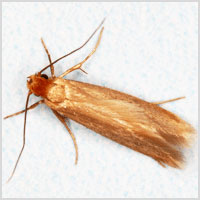Moth
 Common Name: Clothes Moth
Common Name: Clothes Moth
Scientific Name:Tineola bisselliella
Introduction:This indoor insect is common throughout Britain and the world with the exception of the tropics. The common cloth moth is notorious for feeding on clothing and natural fibres; they have the ability to turn keratin, a protein found in hair and wool, into food. As their food must contain moisture, cloth moths are attracted to carpet and clothing that contains human sweat or other liquids.
Recognition: Clothes moths measure about 4-7mm and their wings are long and narrow. The wings and body are uniformly a buff golden or straw colour except for a tuft of reddish scales on top of the head. The larva is mainly white and has a brownish head. With cloth moth infestation, clothing, fabric or carpet will have orifice or holes. In most cases clothes moths can be seen on walls or clothing whereas larva will be seen only on the infected fabric.
Biology:Egg>Larva>Pupa>Adult. The total life cycle of a common clothes moth is about three to ten months. Female moths can mate and lay eggs after emerging from the silken cocoon. Each female lays an average of 40-50 eggs (range 30 to 221), either singly or in small groups over a two to three week period. Eggs are glued to the material. The eggs are hatched within one to five weeks at a temperature of 10-33 degrees Celsius and about 70% humidity. The larvae are whitish in colour, they spin a silk tube or tunnel into which are incorporated fibres and debris which provides a camouflage. They will then feed within the confines of the tube or case that will serve as a home through the larval stage. Cloth larva will emerge to feed at night and return to the safety tunnel during the day. The larval will undergo 5-40 moults for pupation, between 2-7 months depending on the temperature. The pupa is formed inside the final larval case and will remain concealed for one to seven weeks until it emerges into adult moths.
Habits : Common cloth moth attack synthetic fibres when they are interwoven with natural animal fibres. They feed on materials such as wool, hair, fur, feathers etc. The larvae prefer to feed in undisturbed locations on the material or fabric. Such locations could be, behind unmoved furniture, winter clothing and unused carpets. The adults do not feed and are not attracted to lights. Females are poor fliers but are fast on their legs and run when disturbed. Males may fly up to 100 yards but seldom do so. When disturbed, they quickly seek a hidden place such as in fabric folds.
Control: Clothing made of such fabric should be dry cleaned. If materials are much infested, they should be disposed. Upholstered furniture, blankets, carpets and rugs comprising of such fabric should be professionally cleaned and treated with insecticide. Pet hair and fur on floors should be vacuumed. Vacuum bags should be discarded of after cleaning. Good hygiene practice will also minimise infestation, we can advise on all matters of pest control in London.




























